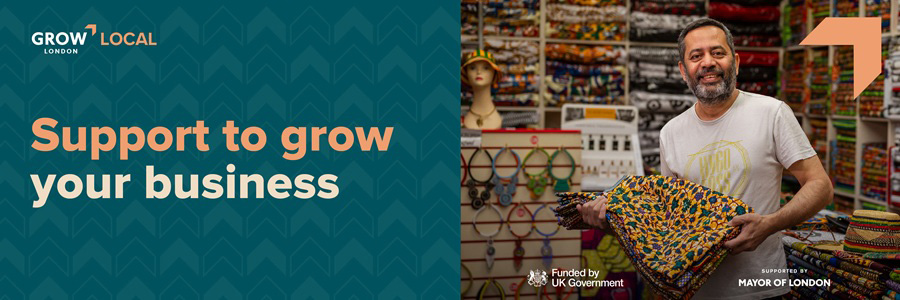How to identify your target audience – and make your marketing work harder

Grow London Local
Posted: Tue 14th Oct 2025
Getting people through the door (or onto your website) is tough enough without wasting time and money talking to the wrong crowd.
The key to better marketing isn't shouting louder – but knowing exactly who you're speaking to.
Defining your target audience helps you focus your efforts, connect with the right people and grow your business without stretching yourself too thin.
When you're clear on who your customers are, what they care about and where to reach them, everything else becomes a little easier – from what you post on social media to how you price your products.
This blog explains how to figure that out, even if you're short on time or working with a tight budget. It keeps things simple, useful and relevant – no jargon, no fluff, just practical steps you can start using today.
What happens when you know who you're talking to
You can't (and shouldn't try to) sell to everyone. Whether you're a coffee shop in Tooting, a tech startup in Stratford or a dog groomer in Kilburn, your audience isn't everyone. And when you try to talk to everyone, you end up connecting with no-one.
Defining your target audience means you can:
Craft messages that genuinely resonate.
Spend less money reaching the right people.
Build stronger relationships with customers.
Improve your products and services based on real needs.
So, how do you actually do it?
Defining your target audience step by step
Step 1: Segment your audience
Start by breaking down your potential audience into segments. Think of this like sorting a big messy pile into smaller, more manageable ones.
Here are a few common ways to do it:
Demographics: this includes age, gender, income, education level, occupation and so on. For example, a small gym in Clapham might target people aged 25 to 40 with disposable income and a keen interest in health and fitness.
Location: if you're a local business, geography matters. A mobile bike repair service in Dalston doesn't need to waste time marketing to people in Richmond.
Behaviour: what do your ideal customers do? How do they shop? Where do they hang out online? Do they buy based on recommendations or price? Have they used your service before?
Needs: what specific problem are they trying to solve? Why might they be searching for a product or service like yours in the first place?
Step 2: Use what you already know
Even if you don't have a fancy CRM system or a big budget for research, you likely already have valuable data. You just need to know where to look.
Customer feedback: what are people telling you in reviews, emails, social media DMs or even face-to-face?
Website and social media analytics: check where your visitors come from, what content they engage with and what pages they leave.
Sales records: what's selling well and to whom?
Competitor reviews: what are people saying about businesses similar to yours? What are they praising or complaining about?
Pay attention to patterns. If you notice that most of your repeat customers are young professionals who shop after work, that's a clue.
Step 3: Get under their skin
Once you've got a handle on the data, go a bit deeper. Try to understand not just who your customers are, but why they behave the way they do.
Ask yourself:
What challenges do they face in daily life?
What frustrates them about businesses like mine?
What's most important to them – price, quality, speed, service?
This is where you start identifying pain points (problems they want solved) and motivations (reasons they might choose your business over someone else's). The better you understand these, the more relevant and persuasive your marketing becomes.

Step 4: Create buyer personas
Yes, it's a marketing term, but it's worth using – and we'll keep it simple.
A buyer persona is basically a short profile of your ideal customer. It brings together everything you've learned so far into one useful picture.
Let's say you run a vegan bakery in Brixton. One persona might be:
Name: Sophie
Age: 31
Lives: Peckham
Job: Freelance graphic designer
Goals: Wants tasty treats that fit her ethical values
Pain points: Fed up with bland vegan options
Buys via: Instagram and local pop-ups
You might have more than one persona – and that's fine. But don't go overboard. Start with two or three at the most.
Step 5: Understand your local market
London's a big place. But the hyper-local nature of many small businesses means it's crucial to pay attention to your immediate surroundings.
Who else is offering something similar in your area?
What are they doing well?
Where are the gaps you can fill?
You don't need a deep dive into market research – just look at what's on your high street, browse Google reviews and follow other local businesses on social media. You'll quickly spot trends, opportunities and ways to stand out.
Step 6: Match your offer with your audience
Once you know who you're speaking to, you can fine-tune what you're offering to suit them better. That might mean:
Adjusting your opening hours to match customers' routines.
Offering products at a price point that matches local income levels.
Adding a new service based on common requests.
The better your offer fits your audience, the easier it is to sell – and the less you have to shout.
Step 7: Tailor your messaging
Different audiences respond to different messages and tones. If your ideal customer is a 50-year-old business owner, the tone of your Instagram captions shouldn't sound like they were written for students.
Think about:
Language: formal or casual? Friendly or expert?
Channels: are they on LinkedIn, Instagram, Facebook or TikTok?
Content: do they prefer quick tips, in-depth blogs, videos or visual posts?
You don't need to be everywhere – just where your audience already is.
Step 8: Use simple tools to learn more
Audience research doesn't have to cost a fortune. There are plenty of free or low-cost tools to help you dig deeper.
Google Analytics: understand who's visiting your site and what they're looking at.
Meta Insights (Facebook and Instagram): see who's engaging with your posts.
Free surveys: tools like Google Forms or Typeform can help you collect opinions quickly.
Email polls: ask your email subscribers a one-question poll to learn what matters to them.
In-person conversations: never underestimate the power of simply asking your customers what they want.
Step 9: Review and refine
Defining your target audience is an ongoing job. People change, markets shift and your business will evolve. What worked six months ago might not work today.
Make it a habit to check in every few months:
Are you still attracting the right people?
Have your customers' needs changed?
Is your messaging still resonating?
If not, tweak your personas, update your marketing and adjust your offer. Small changes can make a big difference.
Final thoughts
Think of defining your target audience as getting clear on who you want to serve, what they actually need and how you can reach them in a meaningful way.
When you do that, your marketing becomes sharper, your message lands better and your business grows – without wasting time or money on guesswork.
Support available on Grow London Local
If you're looking for free support that complements the ideas in this blog, the Grow London Local platform has a growing list of practical offers tailored to London-based founders like you:
Read more
Market research for your London SME: a practical, no-nonsense guide
Buyer personas explained: Examples, benefits and how to create them
Grow London Local: Support for London's small businesses
No matter where you're based in London, you'll find relevant support and guidance on business planning, sales and marketing and much more, as well as opportunities to connect with like-minded business owners. Visit Grow London Local now
Grow London Local
Disclaimer: The content provided on this site, whether by Grow London Local or by third parties, is by way of general guidance only. Grow London Local does not accept any liability for any loss or damage that any person incurs as a result of any content on this site. Please note that where you purchase paid services or content from third parties, your agreement is solely with those third parties.
Subscribe now
Never miss a post with the latest insights and updates.
You can view a sample here.
By subscribing you agree to our Terms of Use and Privacy Policy. You can unsubscribe at any time by using the "Unsubscribe" link at the bottom of any email we send you.
